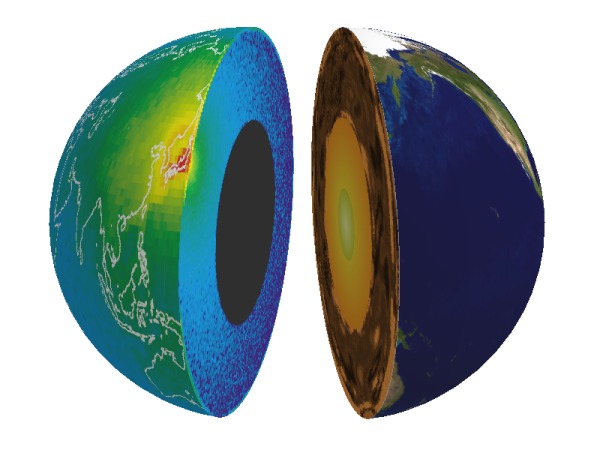
Scientists have tentatively identified several particles lurking deep inside the Earth's mantle that could reveal how much heat the planet produces and confirm that the Earth formed from materials from the sun.
The wacky particles are called geoneutrinos, or the antimatter partners of neutrinos (exotic fundamental particles that can pass right through Earth), that form deep within the Earth's mantle. Every matter particle has an antimatter partner particle that has an opposite charge, and when the two meet they annihilate each other. The findings were detailed described March 11 in the preprint journal arXiv.org.
Geoneutrinos aren't the only particles scientists are hoping to find inside Earth. An experiment using the Earth as a source of electrons recently narrowed down the search for a new force-bearing particle, possibly the so-called unparticle, placing tighter limits on the force it carries.
Giant Engine
When Earth formed, the radioactive elements thorium and uranium were distributed in Earth's interior at different concentrations within the crust (the planet's outer layer) and mantle. As these elements within the mantle radioactively decay, they give off heat and also form subatomic particles known as geoneutrinos, said study co-author Aldo Ianni, a physicist at the Gran Sasso National Laboratory in Italy.
The heat formed from this decay is the engine that drives the motion of the viscous, oozing material that forms the Earth's mantle. That, in turn can shift the tectonic plates, causing earthquakes. Whereas researchers have models to predict how much heat is generated inside the Earth, measuring it has proved tricky. [50 Amazing Facts About Planet Earth]
That's partly because mantle lies miles beneath the Earth's surface, so "if you want to understand how much heat is produced by these radioactive elements, the only way today to understand how much is this so-called radiogenic heat is through the geoneutrinos," Ianni said.
Sign up for the Live Science daily newsletter now
Get the world’s most fascinating discoveries delivered straight to your inbox.
Tiny Particles
To do so, researchers at the Gran Sasso underground laboratory, which is nearly a mile below a mountain in Italy, looked for signals in a vast pool of oil-based liquid that scintillates, or produces flashes of light when particles such as protons pass through it. When geoneutrinos pass through the scintillating liquid they bump into protons and emit a positron and then a neutron, creating a distinctive signal, Ianni told LiveScience.
Many of the particles they initially identified actually came from nuclear reactors from power plants. But by measuring the energy levels of the neutrinos, they could isolate the 30 percent that came from the Earth's mantle, Ianni said.
The geoneutrinos are created from the decay of radioactive thorium and uranium in a reaction that gives off a known amount of heat. As a result, how frequently the researchers find the particles can reveal the quantity of the radioactive elements lurking in Earth's mantle, and in turn how much heat they generate. That can help scientists refine their knowledge of plate tectonics, Ianni said.
But it may also confirm the theory that the Earth formed from the sun, Ianni said. Meteorites that come from the solar system's early history contain distinctive ratios of uranium and thorium that very closely mirror the composition of the sun's surface. By comparing that ratio with the amount found inside the Earth, they can confirm the Earth's solar origins.
Follow Tia Ghose on Twitter @tiaghose. Follow LiveScience on Twitter @livescience, Facebook & Google+. Original article on LiveScience.

Tia is the managing editor and was previously a senior writer for Live Science. Her work has appeared in Scientific American, Wired.com and other outlets. She holds a master's degree in bioengineering from the University of Washington, a graduate certificate in science writing from UC Santa Cruz and a bachelor's degree in mechanical engineering from the University of Texas at Austin. Tia was part of a team at the Milwaukee Journal Sentinel that published the Empty Cradles series on preterm births, which won multiple awards, including the 2012 Casey Medal for Meritorious Journalism.









